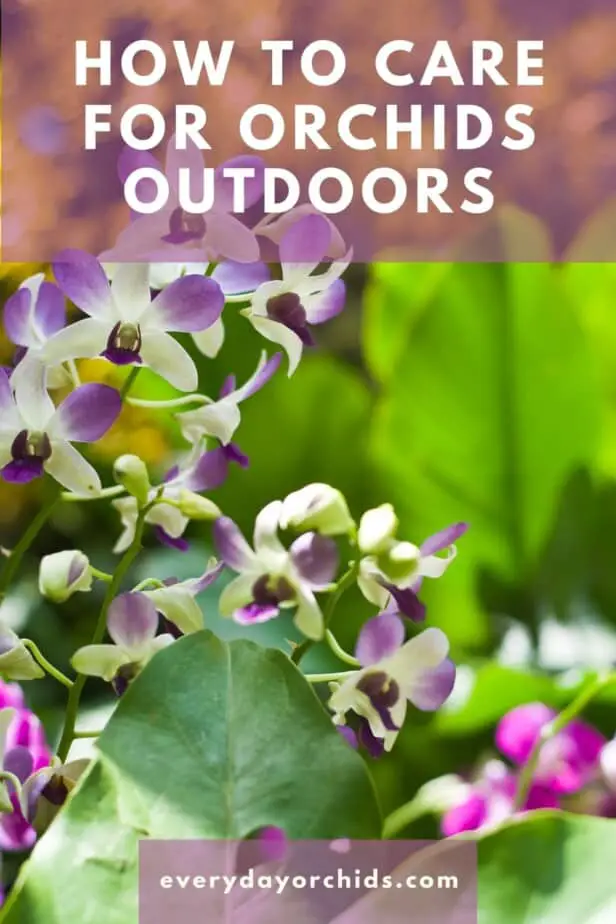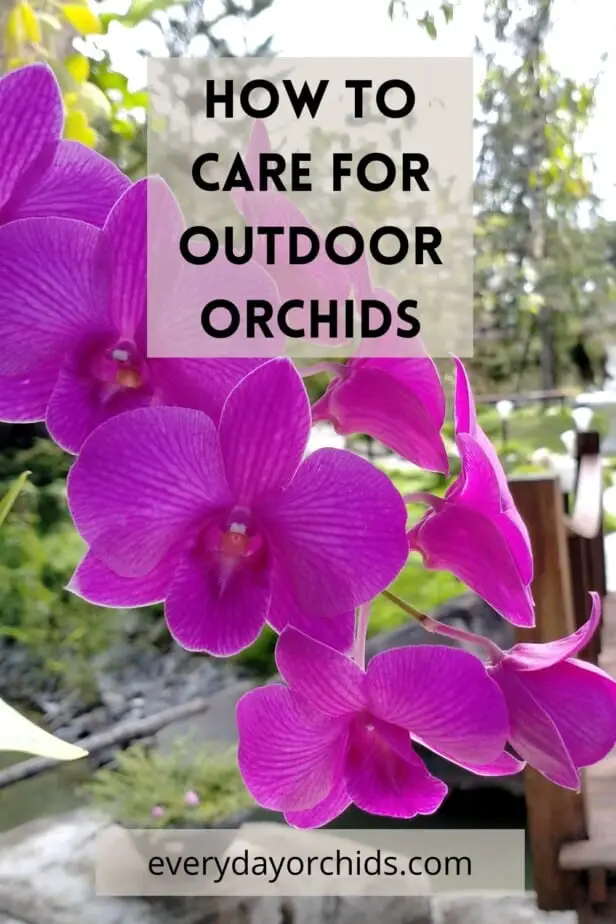Have you ever wondered if you can leave your orchid outside, and if you do, how to care for your orchid outdoors? Most times, orchid growers will keep their orchids indoors or in a greenhouse, but there are certain orchid varieties suited for outdoor living.
Outdoor orchids may need certain adjustments in their orchid care, such as provision of a shade canopy to prevent sunburn, or more watering during hot weather. If you are interested in learning more about how to care for orchids outdoors, keep reading to find out more.
You can leave your orchid outdoors depending on the orchid type and your climate. Many terrestrial orchids are suited for outdoor living. Some orchids, like Vanda, thrive in hot, humid conditions, with slight nightly temperature drops. Others, like Cymbidium, need warm days and cooler nights. Winter-hardy orchids can tolerate freezing temperatures, making them suitable for outdoor living as well.

Before you give your favorite orchid a place in your garden, do you know its temperature tolerance range? Just as important, do you know what to do if it is damaged by over-exposure to light or temperature extremes? If not, you can find out about these and more below. Using this information, you can determine if your orchid can survive or even thrive outdoors.
Please note that these links are affiliate links and as an Amazon Associate, I earn from qualifying purchases. Purchases made through affiliate links in this post may generate commissions at no additional cost to you. Use this link for a discounted Amazon Prime trial. Thank you for your support!
Table of Contents
Can Orchids Survive Outdoors?
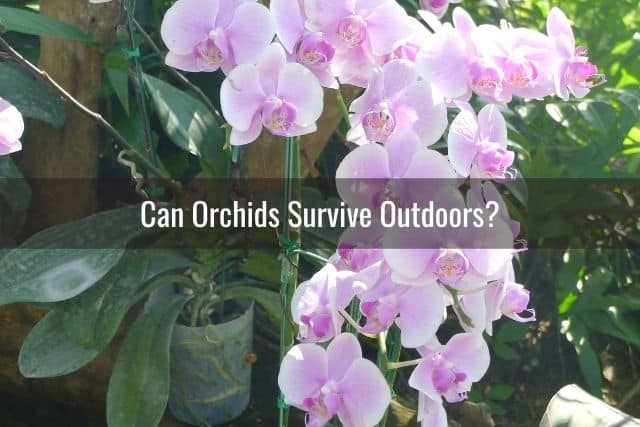
Orchids that usually reside indoors, like humans, benefit from exposure to fresh air no matter how delicate they may seem. However, timing is everything, as I will explain below.
Spring
When the winter chills start giving way to warmer spring days, putting your orchids outside seems like the most natural thing to do. However, do not automatically assume that it is safe to do so in the spring. Unless your climate is very mild, spring frosts can still pose a threat. Frost is the enemy of many plants, including orchids.
Typically, epiphyte orchids that are mounted to trees are at highest risk for frost-exposure. These are also the type of orchids you will see most often in homes. An example of an epiphyte orchid is a Phalaenopsis orchid.
Terrestrial orchids such as Cymbidium or Cypripedium (Lady Slipper) orchids fare much better outdoors. Terrestrial orchids are planted in the ground. Many are winter-hardy and spring frosts are necessary for flowering. In fact, some winter-hardy orchids can survive temperatures as low as -20°F (-29°C).
You should always check the temperature tolerance of your specific orchid before you risk putting it outside. If in doubt, it is best to wait until the danger of frost has passed before moving your orchids outdoors.
Summer
Once the risk of spring frosts has passed, most orchids will enjoy being outside. They will benefit from the natural light and free air movement.
While bright, natural light is beneficial, direct sunlight can be harsh and can cause damage, especially to the foliage. You will find more on this later on. For now, remember that orchids are prone to sunburn and leaf damage if exposed to direct sunlight.
Ideally, you should place your orchids under trees where sunlight can filter through the tree’s leaves. Place your orchids in a location that is not overly shaded. This way, your orchid can still receive adequate lighting. By increasing humidity and airflow, you can help your orchids tolerate higher temperatures as well.
Fall
Fall is when you usually start thinking about bringing your indoor orchids back inside. This is part of fall orchid care. This will protect them against the risk of autumn frosts. If your fall season is very mild, then you may not need to bring your orchids inside until it gets closer to winter.
Many orchids will suffer if left out in freezing conditions. Again, you will need to know what type of orchid you have. You will also need to know your orchid’s temperature tolerance range and the temperature zone or climate you live in.
Many winter-hardy terrestrial orchids can survive freezing temperatures. To help these orchids get through the cold winter months, add a layer of mulch around their base. This will protect their shallow roots.
Winter
If your winters are mild, leaving orchids outside in the winter is usually not a problem. However, different orchid species will have different temperature tolerance ranges. I know I keep saying that, but it really is key.
Some orchids may be able to handle nighttime temperatures down to 10 degrees Fahrenheit, while others can only handle nighttime temperatures down to 50 degrees Fahrenheit. This is true even for terrestrial orchids.
As you would expect, you may not be able to leave your orchids outdoors in climates with cold winters, especially where temperatures linger below freezing for extended periods of time. In those conditions, most orchids will need to be moved indoors.
However, some orchids you might typically think of as indoor plants can survive brief forays below freezing. Some Dendrobiums fall into this category, but more on that in the next section.
As mentioned above, some winter-hardy orchids that you will also read about later can flourish in cold temperatures even down to -20°F (-28°C).
Orchids can survive outside, but it really depends on your specific orchid and its species. This is why you need to know the specific temperature tolerance of your orchids. Here is an article with some tips on how to care for your orchids during the winter.
What Is the Temperature Tolerance Range for Orchids?
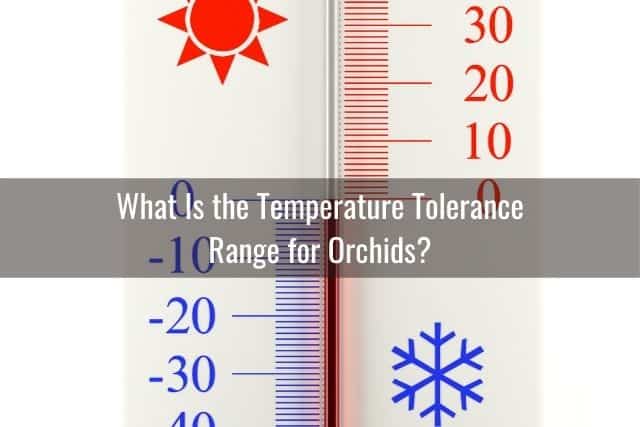
Orchids are native to so many different regions of the world and can survive in a wide variety of climate conditions. In fact, there are thousands of orchid species from virtually all corners of the world.
Some orchids hail from areas where frosts are common, while frost-free, tropical environments make up others’ natural habitats.
So, it will come as no surprise that temperature tolerances vary depending on the orchid species.
Additionally, most orchids need a temperature difference of 10 to 15°F (-12 to -9°C) between day and night temperatures. It is this day-night temperature difference that promotes flowering.
Generally speaking, you will find that orchids fall into three broad temperature ranges. I can summarize these as follows, with some examples of common orchids that fall into each category:
| Day | Night | Popular Orchids in this Category | |
| Cool | 60–70°F (15-21°C) | 50–55°F (10-13°C) | Cymbidium, Dendrobium nobile, some Odontoglossum, Ludisia Discolor |
| Intermediate | 65–75°F (18-24°C) | 55–65°F (13-18°C) | Cattleya, Paphiopedilum, Miltoniopsis. Oncidium (Dancing Lady or Butterfly orchid), Dendrobium antennatum |
| Warm | 70–85°F (21-29°C) | 65–70°F (18-21°C) | Phalaenopsis, Vanda, Dendrobium affine, Dendrobium phalaenopsis |
Remember, these ranges are only meant to be general guidelines. You will find that many orchids favor a tighter or broader range. Some orchids may prefer a daytime temperature in one category, but a nighttime temperature in a different category.
It can get confusing. Below, I will try to lay out the temperature tolerance ranges for some of the most popular orchids.
Phalaenopsis
Phalaenopsis orchids, or Moth Orchids, are one of the most popular orchids out there. Most people have had or been given one at some point, and you often see them for sale at large grocery stores.
As you can see in the chart above, these orchids fall into the warm-growing category. Generally, Phalaenopsis orchids thrive when daytime temperatures range between 75-82°F (24-28°C).
However, you will need to get the nighttime temperatures down to around 55-65°F (13-18°C) to promote flowering. That is below the nighttime range for warm-growers in the table. Warmer night temperatures tend to restrict bloom production. This is why the temperature ranges in the table above should only serve as a guide.
Dendrobium
There are over 3,000 Dendrobium species on the World Checklist of Selected Plant Families (WCSP).
Their natural habitats are spread throughout Asia and the Pacific region. Thus, it will be no surprise that natural growing conditions are diverse within the species.
Some Dendrobiums enjoy a tropical environment. Meanwhile, others grow in the cool air of high-altitude mountainous regions. As a result, you will see Dendrobiums in all three temperature tolerance categories in the table above.
You will need to understand your specific Dendrobium’s natural growing environment if you want to keep it happy.
Helpfully, the species are divided into categories, making it easier to identify the relevant temperature tolerances for a your Dendrobium orchid.
Cool-Growing Dendrobiums
Dendrobiums that thrive in cool conditions fall into the categories known as Callista, Dendrobium, and Dendrocoryne.
Within these categories, you will find species such as D. densiflorum, D. nobile, and D, speciosum. These species relish temperatures down to the mid to low 40°F (4.5°C).
Those low nighttime temperatures are what encourage flowering. Without these temperature drops at night, these species tend to produce more leaves than flowers.
Intermediate To Warm-Growing Dendrobiums
Dendrobiums within the Spatula and Phalaenthe categories tend to enjoy intermediate nighttime temperatures. Examples are D. antennatum and D. affine. There is also D. Phalaenopsis. It is so-called because it resembles the Phalaenopsis orchid.
Orchids in this group do best if you keep nighttime temperatures above 60°F (15°C). They often suffer if minimum temperatures fall below this. One sign of this stress is leaf loss. To avoid this, you will need to keep nighttime temperatures in the 60-65°F (15-18°C ) region.
During the day, most in the Spatula group can tolerate temperatures above the intermediate daytime range. Even temperatures up to 90°F (32°C ) will suit them.
Most orchids in the Palaenthe group also enjoy higher daytime temperatures, but at around 82°F (28°C).
Oncidium
The popular yellow-flowered Oncidium, is also “Dancing Lady.” This orchid species falls within the intermediate temperature tolerance range.
Oncidium hybrids like Miltonidium, which is a hybird of the Miltonia and Oncidium orchids, also fall into the intermediate temperature tolerance range. This is also true of other hybrids, such as the Brassidium, a hybridization of the Spider Orchid, Brassia, and Oncidium.
Remember, intermediate temperature lows are around the mid-50°F (10°C) mark. But some Oncidium hybrids such as Burrageara and Wilsonara can cope with temperatures down to the mid-40°F (4.5°C) range.
Cymbidium
Cymbidium orchids are ideal for cooler growing conditions, though they need to remain frost-free.
Those with large blooms flower well if you can keep night temperatures no higher than about 53°F (12°C). Some Cymbidium varieties, however, need night temperatures down to the 40°F (4.5°C) area to deliver their best flower display.
In contrast to their need for cool nighttime temperatures, Cymbidiums cope well with daytime highs well above those usually associated with cool-growing orchids.
They can tolerate temperatures as high as 90°F (32°C), provided that these temperatures are accompanied by high humidity.
However, do not allow your Cymbidiums to get too hot during the day. This is especially important during the fall season, when these orchids are starting to develop flower buds. Daytime heat at that stage can result in bud loss and orchid flowers falling off early.
Other Popular Orchids
Vandas
Vanda orchids are heat-lovers. If you can give them daytime temperatures into the 80°F (27°C) area, they will even tolerate some nights down to 50°F (10°C).
Be careful though. Vandas will not appreciate prolonged or frequent temperature drops down that low. If they start dropping their leaves, this is an indication that your Vandas are too cold. Keep white or yellow Vanda orchids above 60°F (15°C) if you want to avoid leaf loss.
Cattleya
Cattleya, or corsage orchids, thrive best in warm-intermediate temperature conditions. Maintain daytime highs between 70-85°F (21-29°C) and nighttime lows between 55-65°F (13-18°C). These temperature ranges make these orchids ideal for most household environments.
Some Cattleya that are native to higher altitudes have no difficulty with temperatures down to the high 40°F (4.5°C) range. However, as with most orchids, it is crucial to maintain frost-free conditions.
Paphiopedilum (Slipper Orchid)
Paphiopedilum orchids can have either plain green leaves or mottled leaves.
The plain green leaf varieties do best at the cool end of the night temperature range. That means you will need to keep nighttime temperatures between 50-55°F (10-13°C).
In contrast, the mottled leaf Paphiopedilum orchids need a higher nighttime temperature range between 60-65°F (15-18°C) to do well.
You can be a bit laxer with the daytime temperatures for both types.
Most plain green-leafed Paphiopedilum orchids tolerate temperatures up to 77°F (25°C). The mottled-leafed variety will be fine even if daytime temps hit the mid-80°F (27°C) mark.
Miltoniopsis (Pansy Orchid)
One look at the delightful blooms on the Miltoniopsis orchid, and you will understand why it is known as the pansy orchid.
If you want this orchid to reward you with these fragrant, delicate flowers, provide it with night temperatures between 55-60°F (13-15°C). Couple that with daytime temperatures between 70-80°F (21-27°C), and both you and your Miltoniopsis will be very happy.
How To Treat Heat/Sunburn Damage on Orchids Outdoors
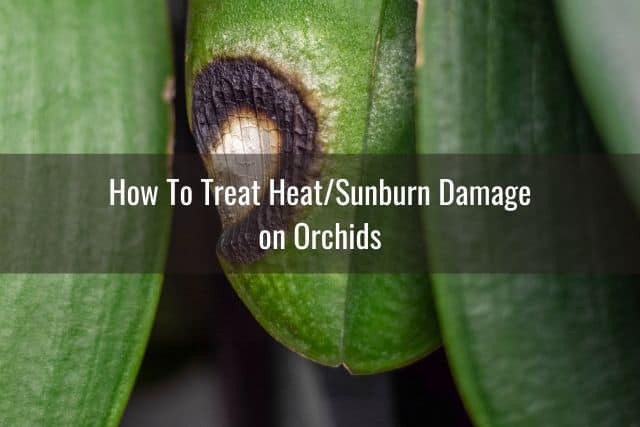
Despite their tropical looks, most orchids do not take well to exposure to direct sunlight. Plenty of natural bright light is a must for orchids, but that light needs to be filtered.
If your orchids are outside, they should be under a tree canopy or an artificial covering over your outdoor space. For example, a covered balcony or a tree can protect your orchids from direct sunlight exposure while still providing ideal light conditions.
For indoor orchids, you can shield them from direct sunlight using a thin curtain. This is especially needed if your orchids sit near a sunny window.
You will know if your orchid is suffering from heat or sunburn damage by looking at the leaves. Sun damage is seen as unsightly dark-ringed dry-ish white patches or yellowing on the leaves. Sometimes, the leaves can turn a deep purple color. If left untreated, those leaves will eventually turn brown, and the plant could die.
For more insight about orchid leaf color, you can read more about why orchid leaves change color and what changes in color mean.
It is easy enough to prevent the death of a sunburned orchid if you take decisive action quickly. As soon as you spot sun damage on your orchid’s leaves, get your plant under some shade. Unless the damaged leaves show signs of rot, it is safe to leave them on the plant.
Those leaves should dry out and will not do the plant any harm. If they do go mushy with rot, then remove them quickly to stop the rot from spreading.
How To Treat Cold Damage on Orchids
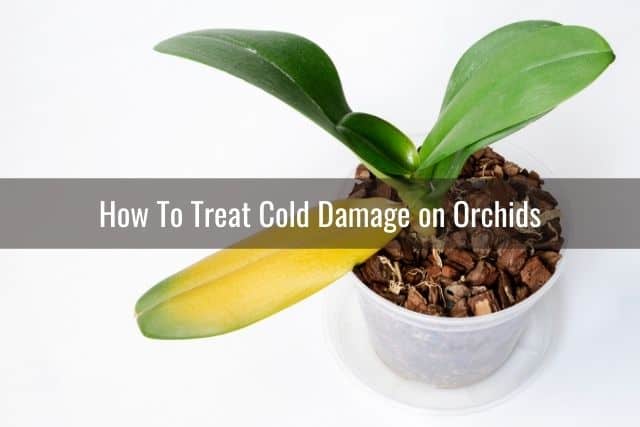
As you may have gathered by now, temperature drops at night are vital to initiating flowering in orchids.
Despite their delicate appearance, many orchids can cope with temperatures in the 30-40°F (-1-4.5°C) range. For some orchids, brief periods at low frost-free temperatures will yield a bounty of flowers.
However, most orchids prefer minimum temperatures in the 50-60°F (10-15°C) zone. Prolonged colder spells can damage plants.
Orchids suffering from cold stress will display various symptoms. Watch out for limp brown or black leaves or brown or black pitting on the leaves. I discuss how to care for orchids experiencing cold or frost damage in this article about how to care for orchids in the winter.
You will see this kind of damage appear soon after over-exposure to cold or freezing temperatures.
However, if cold stress affects the orchid roots, this will not manifest until much later. You will notice something is wrong when the plant fails to put on its usual spring growth.
This is why it is so important to monitor day and nighttime temperatures. As soon as you suspect over-exposure to cold, your quick action can save the plant.
Move your orchid somewhere humid and continue with your regular orchid care. Allow the growing medium to dry out naturally. Let new growth appear before you start watering it again. Direct sunlight, high temperatures, and watering will only make matters worse at this stage.
Follow these steps, and you should see the eventual development of new leaves and roots.
How To Treat Frost Damage on Orchids
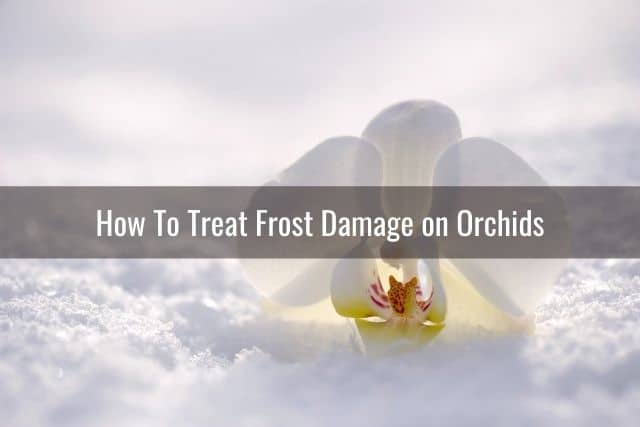
Although some orchids can tolerate brief periods around 30-40°F (-1-4.5°C), one thing you want to avoid the most is frost.
Frost can occur once temperatures drop below 32°F (0°C). Any water on the leaves will freeze below this level.
Tell-tale signs of frost damage are leaf or stem desiccation, pitting, lesions, or sunken areas on leaf surfaces. If you are faced with frost damage, the treatment is similar to that for cold damaged plants.
Essentially, your orchid will need a cool but humid environment with lots of natural light to minimize frost damage. Once again, it is vital to avoid high temperatures and direct sunlight. If the growing medium has frozen, you will need to let it thaw naturally.
The humidity will take care of the orchid’s moisture needs. Avoid watering your orchid since adding water at this stage could promote rot and eventual death. You want to keep the growing medium dry once it is thawed, until new growth appears.
Even when new growth develops, water only with plain water. Do not start adding orchid fertilizer for several more weeks. Even then, use only a weak fertilizer solution until you begin to see new roots. Once that happens, you can water and fertilize as usual.
Where Is the Best Place To Put Orchids Outdoors?
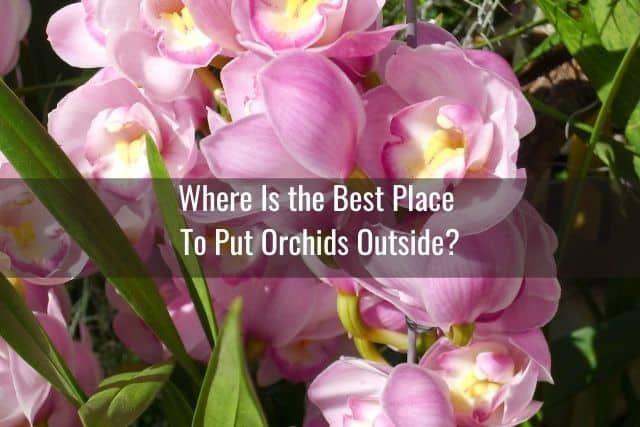
If you want to give your indoor orchids a taste of fresh air in the warmer months, the best place to put your orchids outside really depends on the type of orchid. You will need to consider your orchid’s specific native growing conditions.
Putting Your Indoor Orchids Outdoors
As you probably have gathered by now, most orchids do not do well in direct sunlight. An ideal spot for orchids is under trees with a decent canopy that will filter the sun’s rays. You do not want to place the orchid under a tree canopy that completely cuts out the sun. Most orchids do not take kindly to dense shade and prefer filtered light.
If you have potted your epiphyte orchids in baskets, you can hang them from tree branches. There, they will avoid direct sun, and the roots will benefit from natural air movement.
If you do not have any trees, look for other garden features that may provide the sun protection your orchids need. For example, smaller potted orchids will fit nicely under a bench. Alternatively, you can put your pots under an arbor or on a covered deck or balcony.
Planting Epiphyte Orchids Outdoors
As you will see in the next section, keeping orchids outside does not need to be temporary if you can provide them with the right conditions. You can make them a permanent outdoor feature, and they do not need to stay in pots. In fact, many terrestrial orchids are able to remain outdoors year-round, provided that you live in the right climate.
If you live in a warm climate and you want a natural-looking outdoor epiphyte orchid display, mount your orchid on a tree. That is where epiphyte orchids grow in their natural habitat.
Their roots cling to the host tree, and in that position, the roots can enjoy the free airflow they need. Their specially adapted roots extract the water from the air and surrounding humidity.
When you mount your epiphyte orchid on a tree, providing a cushion of sphagnum moss will help replicate its natural growing medium. At first, you may need to secure it to the tree branch with some soft string until its roots can start doing their job.
Growing your epiphyte orchids on a tree will also help mimic the light conditions of their natural habitat. You can also create a permanent home for most terrestrial orchids in a raised bed containing an airy, free-draining orchid growing medium.
Growing Terrestrial Orchids Outdoors
In contrast, terrestrial orchids cannot be planted on a tree. As the name suggests, these are ground orchids. They either form pseudobulbs or roots that need to be buried in the soil.
If your orchid has a pseudobulb, that is an indication that it comes from a naturally dry region. The pseudobulb is the plant’s water and nutrient storage facility. On the other hand, the root-type terrestrial orchid comes from wetter areas, so they do not need to store water.
Still, you will need to provide a well-drained growing medium for most of these terrestrial orchids. You should also ensure that your orchids have good protection from direct sunlight to avoid sunburn. An area in your garden where sunlight can filter through other plants, like trees, is an ideal spot.
Otherwise, you can put up a pergola over the planting site and trail climbing plants over it to create a canopy for the orchids below.
Can You Leave Orchids Outdoors Year-Round?

Whether you can leave orchids outside all-year-round depends on the climate in which you live and the orchid.
Climate Conditions
As you have read above, many indoor orchids benefit from being outdoors in the summer. However, if you want to leave orchids outside all-year-round, you will need to know how low temperatures in your area can drop.
Thankfully, the USDA’s Plant Hardiness Zones map provides this information. It shows minimum temperature zones for regions throughout the United States. You will often see these zones referred to in plant descriptions to indicate the lowest temperature a plant can tolerate.
In some US coastal regions, you can expect almost entirely frost-free conditions. In those areas, you can certainly keep most orchids outside all-year-round.
You will still need to have to pay attention to the basic rules of protecting your orchids from direct sun. Also, although orchids enjoy good air movement, excessive winds can damage them. It is best to place orchids in areas that provide shelter from strong coastal winds.
As you can see from the USDA’s Plant Hardiness map, there are several other areas in the southern and central United States where many orchid species will thrive outdoors. However, these areas may not be frost-free. If frosts do happen to threaten, you will need to take steps to shelter and protect a lot of orchid varieties to avoid freezing.
Frost cloth is an orchid life-saver in these conditions, but an old sheet or blanket will work just as well. You can purchase frost cloth at your local hardware store or online. You can also use plastic sheeting such as this one and secure it on supports to enclose your orchids. Plastic will insulate and provide wind protection in colder months.
For any terrestrial orchids in your outdoor collection, most will be fine in cooler outdoor conditions. Remember to protect the roots with a generous mulch layer.
Even if your area is in the lower minimum temperature zones, the good news is you can still leave orchids outside year-round. You just have to choose your orchids carefully.
Orchid Type
There is no big secret to succeeding at keeping orchids outdoors year-round. You just need to pick the orchid that would do well in your climate zone.
For example, do not choose a warm-growing orchid if you live in an area where temperatures regularly drop down to 50°F (10°C). If you live in such a region and your daytime temperatures rise into the 60-70°F (15-21°C) range, many cool-growing orchids will thrive in your area.
The thing is that there is such a wide range of orchids. As a result, you should not have difficulty finding one that suits your outdoor conditions.
For example, if you live in Florida, where the climate is hot and humid, Vanda and Phalaenopsis orchids will do well outside. In Southern California, where mild days give over to cool nights, Cymbidiums will be perfectly happy in the garden all-year-round.
Even if your minimum temperatures tend to drop below freezing, you can still grow orchids outdoors. Just avoid the tree-dwelling epiphyte orchid types as these tend not to do well in those conditions.
Winter-hardy orchids are generally terrestrial orchids that grow in the ground. For example, Bletilla striata’s delicate-looking flowers belie its resilience in colder climates. It is hardy down to USDA Hardiness Zone 6. In fact, there are several Bletilla and Calanthe species and hybrids that can thrive in USDA Hardiness Zones as low as 6. Even more impressive, if you can get hold of the more uncommon dwarf Cypripedium debile, it is hardy down to Zone 5 or even Zone 4.
You probably get the picture by now that there is an orchid to suit many varied climates. Just be sure to research thoroughly. When growing your orchids outdoors, match your choice of orchid to the outdoor climate conditions you can provide.
Final Thoughts
As you now know, you can leave orchids outdoors. The climate in which you live and the type of orchid which you have are key bits of information you will need. This will help you determine whether or not you can leave your particular orchid outside and if you can do so year-round or only during warmer weather.
You may need to spend some time researching, but it will be time well-spent. With so many orchid species that survive in a myriad of climates, you are bound to find one that can thrive in your outdoor space. Happy orchid growing!
If you enjoyed this article, please pin it and share!
